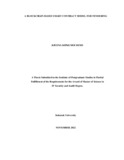A BLOCKCHAIN BASED SMART CONTRACT MODEL FOR TENDERING
Abstract
nformation technology is the backbone for all 21st
-century organizations that are looking
forward to offering better customer service and gaining a competitive advantage. Today,
the blockchain technology is being adopted by several organizations such as financial
service providers, healthcare, agriculture, and even government sectors. Nonetheless, the
procurement sector has adopted information technology in its processes especially with
the advent of E-procurement technology. However, the tendering sector has not been able
to take advantage of the new blockchain technology. This study focuses on the
blockchain and its BYOE (Bring Your Own Encryption) concept in the procurement
sector. Using a proof of concept approach the research came up with a blockchain-based
procurement model for organizations. The model was designed following ASD approach.
While Ethereum based solidity smart contract with Truffle running on 127.0.0.1:9545 and
MetaMask installation was configured for the running environment. In addition, Ganache
running on localhost 127.0.0.1:7545 for the graphical interface was realized. The running
hosted model is available at https://gov.chimera-iot.co.ke/index.php. The model
prototype was evaluated based on the model goals and software quality attributes.
Software quality attributes, was a purely technical evaluation that used test cases to see if
the model requirements were attained. To ascertain the model goals, the evaluation
intended to identify issues related to the various model components and gauge user
experience. At the end of the evaluation process, the functional testing proved that all the
model functional and system requirements were satisfied. The feedback from the users
also indicated that most of the participants were able to accomplish all the model
functionalities. Participants also strongly agreed that the model satisfied all the goals and
software quality attributes. The model verification and validation results showed that the
model design satisfied all the intended objectives. The model was able to automatically
initiate the tender, place bid and perform bid evaluation & relay bid results with relevant
bid reports. The functional model was able to provide transparencies by ensuring bids are
not concealed and ensuring immutability of transaction thus ensuring transparency and
openness. The overall idea was therefore found to be feasible and practical

